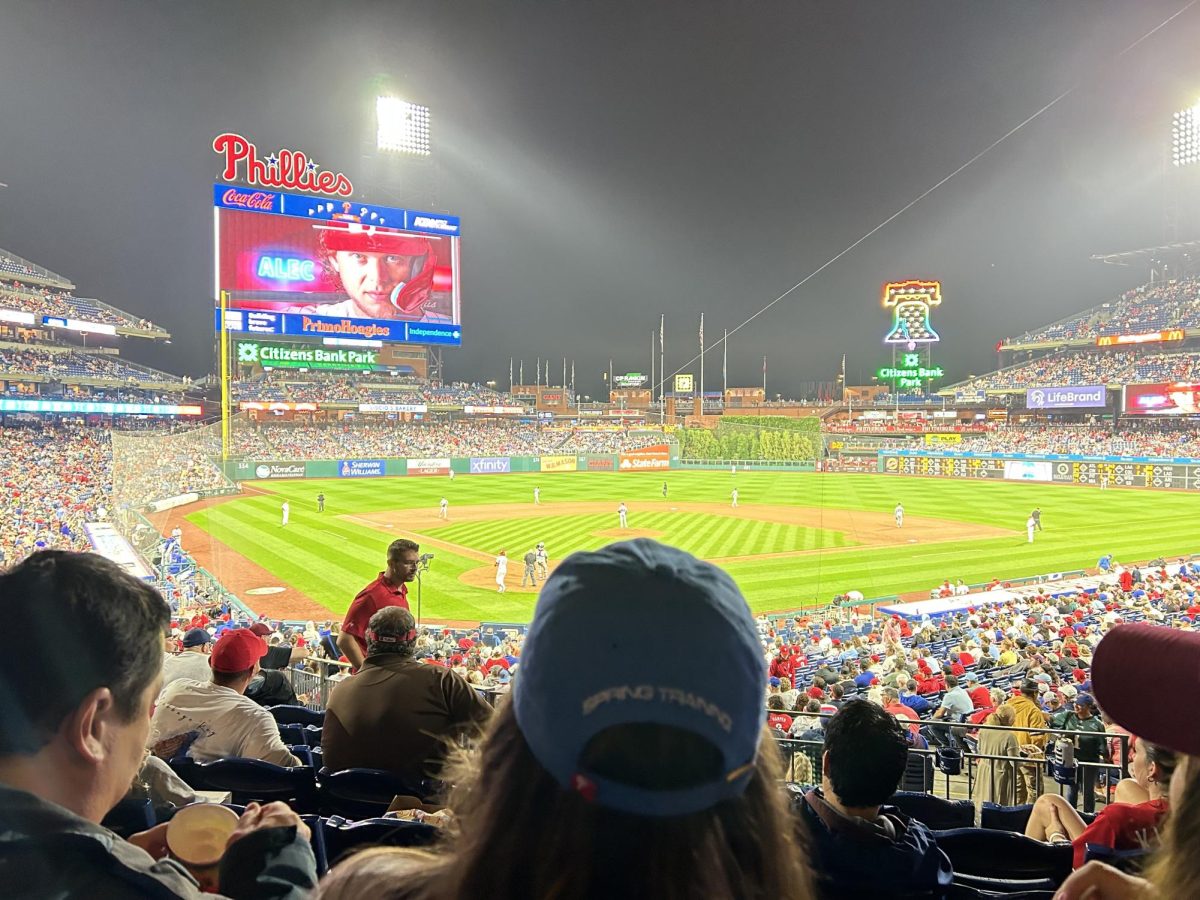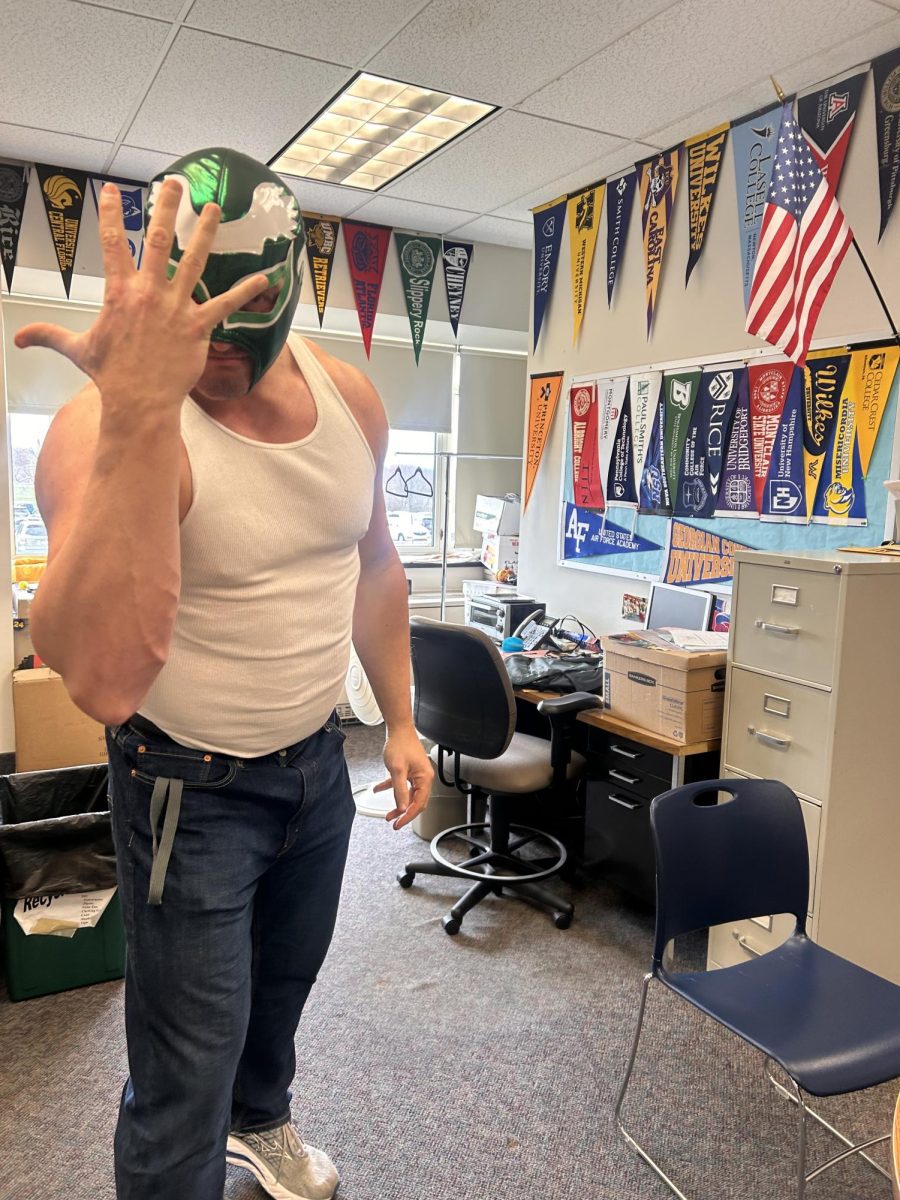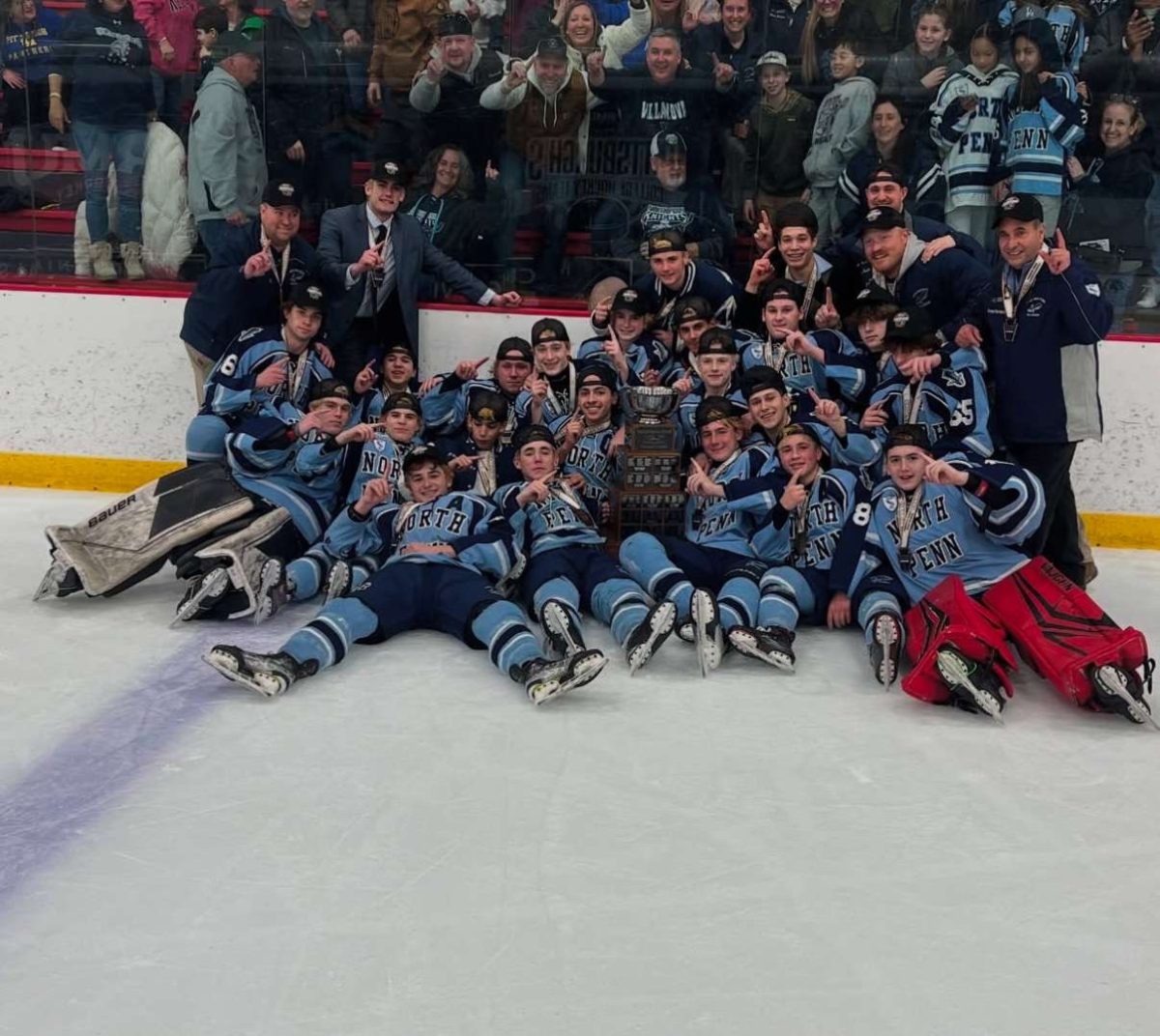EDITORIAL: The Philadelphia 76ers and tanking in the NBA
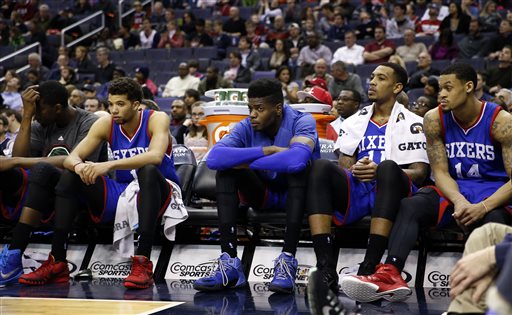
Photo courtesy of AP Images/ Alex Brandon
Philadelphia 76ers center Henry Sims, left, guard Michael Carter-Williams, center Nerlens Noel, forward Malcolm Thomas, and guard K.J. McDaniels sit on the bench late in the second half of an NBA basketball game against the Washington Wizards, Monday, Jan. 19, 2015, in Washington. The Wizards won 111-76. (AP Photo/Alex Brandon)
January 21, 2015
In an ever changing league of fast paced offenses and expanding use of advanced statistics, the fight to create a perennial contending franchise is as intense as ever. It becomes an uphill battle, forcing owners and executives to claw their way out of the bottom of the abyss in an effort to reach the top. The pinnacle is worth the fight, for champions live on throughout history in immortal glory. But many do not make it, losing the will and patience to continue on or losing their footing and falling back to the bottom. Anyway you put it, piecing together a winning basketball team comes with a long list of requirements and a set path to follow. You need talent, development, toughness, courage, personnel, and just a little bit of luck.
The Philadelphia 76ers, though, have decided they know a better way than the proven path, a shortcut to expedite the trip to the top of the mountain. They have displayed a new course of action, one founded on losing, resulting in a word that has become taboo in almost every NBA Fan circle: Tanking.
Even though teams have done this before, losing for seasons at a time to improve for the future, no one has ever done what the Sixers are currently doing. Tanking was mostly just season long, a result of an injury plagued year or the exit of a star player. Yet no matter what, a team has never tried purposely to lose games before. No one likes to lose, because the whole goal of playing the game of basketball is to win. Hell, the whole point of playing ANY game is to win.
Tanking is a detriment to the league, and it is incredibly sad to see the Sixers franchise, once so great, stoop to a level this low.
What is Tanking?
Merriam-Webster defines tanking as follows: to be very unsuccessful, to fail completely, to make no effort to win a contest, to deliberately lose a game, match, etc. In reality, the entire definition could be replaced by the words “Philadelphia 76ers”, because they are synonymous. Tanking in the NBA involves losing games to improve lottery odds in the NBA Draft, where teams hope to find the next franchise piece or maybe even generational superstar. By getting a higher draft pick, the Sixers hope to find the necessary young talent to contend for years to come.
The system, as currently stands, involves the fourteen teams that miss the playoffs. All of these teams are entered into a lottery to determine the order of the top three picks, with the remaining picks (4-14) being determined by every team’s inverse record. Like most normal lotteries, the system is based on a selection of four balls, with the order of numbers drawn is unimportant (4-3-2-1 is the same as 1-2-3-4.) That permutation of four is then applied to fourteen (14!/10! or 14x13x12x11), which is 24,024, and then reduced by a factor of four (14!/(10!x4!)) for a possible 1,001 combinations. The combination of 11-12-13-14 is disregarded, bringing the possible amount of combinations to an even 1,000, which is then distributed amongst the fourteen lottery teams based on worst record (see table below.)
| Slot | Combinations | Chance of winning | Slot | Combinations | Chance of Winning |
| 1. | 250 | 25% | 8. | 28 | 2.8% |
| 2. | 199 | 19.9% | 9. | 17 | 1.7% |
| 3. | 156 | 15.6% | 10. | 11 | 1.1% |
| 4. | 119 | 11.9% | 11. | 8 | 0.8% |
| 5. | 88 | 8.8% | 12. | 7 | 0.7% |
| 6. | 63 | 6.3% | 13. | 6 | 0.6% |
| 7. | 43 | 4.3% | 14. | 5 | 0.5% |
The chances of winning are not sure by any means, and the Sixers learned this lesson in last year’s draft. They fell to the third overall pick despite the second worst record in the NBA and missed out on Andrew Wiggins and Jabari Parker. Obviously, losing games at the rate the Sixers are is still risky, as having the worst record does not guarantee you the top pick. In fact, the team with the overall worst record has not won the top choice since the Orlando Magic selected Dwight Howard in 2004.
The Cleveland Cavaliers and Los Angeles Clippers have the most top selections in that time period with two apiece, but LA sent its pick to Cleveland in 2011, giving Cleveland three of the number one picks in a four year window (2011, 2013, 2014). In 2012, the Charlotte Bobcats set an NBA record for worst winning percentage with .106, but lost out on the first overall pick, falling to number two. The worst that a team can fall is three picks, and the system as is guarantees a top four pick to the worst team in the league.
While Philadelphia thinks they are speeding up the process to find that coveted diamond process, they are ignoring the factors of simple luck. They have mortgaged away quality veterans and younger starters for future draft picks and expiring contracts, failing to see the luck that comes with the draft. Hinkie is like the child at daycare who hoards all the building blocks, but then has no real creative design ideas or intentions. Playing the lottery with an idea that having more picks increases the idea of potentially finding a franchise player is short-sighted, for even if you play the lottery with more chances of winning, it’s still a lottery. Luck cannot be eliminated. And by attempting to do so, the Sixers are ignoring one extremely crucial element in building a future contender…
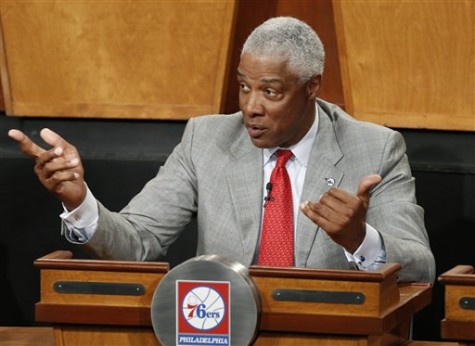
Philadelphia 76ers strategic consultant Julius Iriving is shown on stage during the NBA draft lottery in New York, Tuesday, May 20, 2014. (AP Photo/Kathy Willens)
Player Development
If we look through the greatest teams through the history of the league, we’ll notice that young stars improved steadily throughout their careers. Whether it’s from bench player to role player, from role player to sixth man, from scrub to superstar, every successful team has players who took large steps season to season. There are multiple examples of players like this around the league this year, such as Jimmy Butler in Chicago, to a smaller extent Klay Thompson in Golden State, and both Gordon Hayward and Derrick Favors in Utah. All of these players have been good the past few years, showing flashes of above average ability, but have been put in situations throughout their careers that have set them up to reach the higher gear that they have kicked it into this season. I think the best example of this trend is taking place currently in Orlando, where the Magic now have a stable of young studs on the court on a nightly basis.
Let me run down the list. Tobias Harris was a bench scrub his first year in the league, wasting at the end of the rotation in Milwaukee for a season and a half, only averaging 11.4min with a 14.07 PER in his first season. In fact in his second season with the Bucks, before the Magic picked him up, he was playing almost the same amount of minutes (11.6), but his numbers were down in points, assists, and rebounds, and his PER had regressed to a 13.67. However, Orlando recognized his potential and gave him a chance to show it. And two seasons later, Harris is delivering. The playing time has given Harris a chance to improve his counting stats, averaging career highs in rebounds, assists, steals, blocks, and points (an impressive 18.5 per game) all in 35.5 minutes a night. The development has shown the most in his shooting percentages, where he is shooting a career high in field goal percentage (.472) and three point percentage (.394). Advanced stats also show improvement, where his true shooting percentage (.557) and effective field goal percentage (.512) are at all time highs, and his assist percentage has improved (10.3) while keeping his turnover percentage (10.7) at his career average. Basically, Orlando has provided Harris with the necessary situation, coaching, and resources to further his game every year and help reach his potential. This can also be seen in Nikola Vucevic (synonym for double-double), Evan Fournier (Manu Ginobli incarnate), and Victor Oladipo (actually has a working jump shot). These are all players the Magic have stuck with, patiently helping to build their skills while providing an everyday culture of supportive veteran locker room presences and roster continuity.
The Sixers are literal opposites in almost every meaning of that previous sentence.
They have no veteran presence in the locker room. At last check, the only players listed on the roster over the age of thirty were either injured and wearing depends (Jason Richardson, 34) or did not want to play for the team (Andrei Kirilenko, 33). The next oldest guy on the roster is Luc Richard Mbah a Moute (28), whose name is almost as long as the number years he has been in the league (6). The only other player on the roster who has more than two years of NBA experience is Malcolm Thomas, who barely qualifies with three. They have five rookies (Noel, Sampson, Grant, McDaniels, Aldemir) and one medically inactive (Embiid), and of the twenty-eight players who played at some point on the roster last season, only six are currently still on the roster. One third of their entire current roster went undrafted in their respective draft years.
So they have no continuity. Big deal, they’re young players are showing signs of development, right?
Nope. Only regression and stagnation. Tony Wroten is still a chucker who plays inefficiently (PER below 15 in all three seasons), has an absolutely broken jump shot (.412 FG%, .283 3p%, .659 FT%), and turns the ball over too much to be considered a serviceable point guard (3.91 TOV per game, 19.22 TOV%). Hollis Thompson’s three point range has abandoned him (down to .333 from .401).
But the two prized chips of the Sixers “rebuild” have been the most disheartening, concerning, and downright disappointing of all.
Nerlens Noel has shown minimal, if any, improvement after his year off after ACL surgery. First, his body is too similar. He checked in at 206 pounds at the 2013 NBA Combine, but was quoted saying he played at around 225. His listed weight at the start of this season was 228. In an entire year off, the guy only added three pounds to his playing weight. For an NBA center, that will single handedly destroy his career. If Philadelphia wants him to play the power forward position, he certainly has not shown that either.The only bright spot of ACL surgery is that, after you are able to put weight on it, you can work on upper body shooting mechanics and form, essentially focusing on rebuilding a jump shot. If anything, you can stand flat footed and shoot free throws. Noel has not shown improved mechanics, much less an improved shot, shooting very little outside the paint and converting even less. His free throw percentage is worse than it was at Kentucky (from .492 to .529), and that lack of improvement alone shows either how little he was supported and developed or how little he is able to develop, something incredibly important for a guy who was traded on draft night for an all star. Noel and the Sixers cannot afford stagnation, especially when he already lost an entire season.
Michael Carter-Williams was the lone surprise and bright spot for the terrible Sixers last season, and his Rookie of the Year campaign provided optimism heading into this season, albeit after he proved to be only average efficiently. To say he has hit a wall would be an understatement, for Carter-Williams has regressed across the board. The lack of development in his game has been appalling, both as a shooter and a playmaker. His shooting has been even worse than last year, as he currently stands shooting .382 from the field, .240 from three point range, and .621 from the free-throw line. For someone with a green light and franchise at his fingertips, the slip in scoring efficiency is discouraging, and the fact that he is shying away from getting to the free-throw line this year (4.4 down from 5.2) shows his decisions when scoring are slipping. At 6 foot 6 inches, Carter-Williams should be looking to get to the charity stripe inside, while developing his jump-shot in the offseason. His passing has been even worse as well, with his turnovers per game and turnover percentage far higher than his rookie season (4.4 from 3.5 and 20.1% from 16.9%), which lays out his lack of improvement in running his team. The team is better when he is not playing, shown by the fact that he is posting -1.1 win shares for the season.
What Tanking is Doing to the Sixers
A lack of continuity and player development is concerning, but tanking is infecting the very roots of the Sixers organization. Amidst roster upheaval and reported tensions within personnel, the Sixers stability and organization, or lack there of, is the central downfall of their perpetual losing. There is an obvious disconnect between the coach and front office, which was laid bare a month ago when the Sixers traded Brandon Davies. A bench player and undrafted D-League signee, Davies had endeared himself to both Philadelphia fans and Coach Brett Brown with his consistent play and work ethic. When speaking with Comcast Sportsnet back in December, Brown was frustrated with how the roster shakeups affect the team culture.
“When you start losing people that you are very fond of and have tremendous respect for … there is a human side of it that bothers me because you are trying to grow chemistry, you are trying to grow a culture,” Brown said.
When the head coach takes issue with team changes, theres an obvious lack of communication between the front office and coaching staff, which leads to franchise tensions. For a young developing team, a nurturing and blue-collar environment is crucial in building a winning attitude. In order to win, the Sixers need to be a team and grow together under a hard-working culture. And when a team tanks, the roster instability results in an amorphous culture that never truly grows and takes shape.
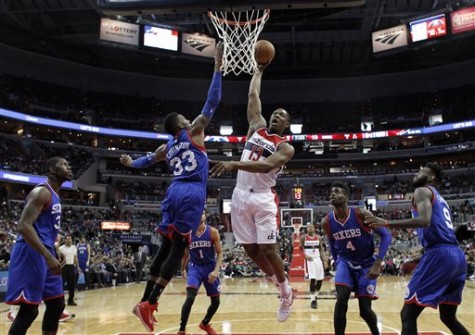
Washington Wizards center Kevin Seraphin (13), from France, dunks in front of Philadelphia 76ers forward Robert Covington (33) in the first half of an NBA basketball game, Monday, Jan. 19, 2015, in Washington. The Wizards won 111-76. (AP Photo/Alex Brandon)
Lately, there have been reported tensions between the teams building blocks as well. Joel Embiid, the team’s top draft pick this past year and possible franchise center, has skipped conditioning sessions while rehabbing his foot injury and blew up at a team trainer in another therapy session. There are also conflicting reports about his weight, which is pushing 300 pounds. All of these rumors have also come with reports of Noel’s recovery last season, which yielded similar blow ups and malcontent. Whether they are true or not, these rumors are worrisome for a young developing franchise for it shrouds the team in a state of doubt. Players get touchy, young players develop egos, and chemistry dive bombs. Entitlement for a 20 year old is a dangerous thing, and throw in millions of dollars to put a ball through a hoop, and the line between stability and instability becomes very fine. Veterans are usually used in this case to keep young players in shape, but with a lack of veteran presence on the Sixers, there are fewer options to reign in the unruly players.
Coach Brown said it himself. When you have a young developing team, it all comes down to culture and building an environment of success. Hard work cannot be something that is given on a whim. It has to be demanded, from the starters to the bench, and anything less in unacceptable. The continual roster instability, lack of continuity, and absence of any veteran presence only hinders personal player development. Compound that with a lack of accountability and care for development, and you arrive at where the Sixers currently stand; shaky, unpredictable, and surrounded by doubt.
Doubt is the result of tanking, and the league has to find a way to prevent other teams from following the Sixers down the rabbit hole. For the sake of Philadelphia fans, NBA fans, and the basketball Gods, tanking must be stopped. Period.






